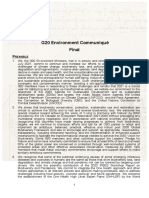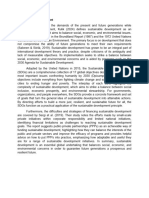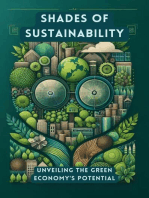National Env Policy 2018
National Env Policy 2018
Uploaded by
fvhbs9ghnrCopyright:
Available Formats
National Env Policy 2018
National Env Policy 2018
Uploaded by
fvhbs9ghnrOriginal Title
Copyright
Available Formats
Share this document
Did you find this document useful?
Is this content inappropriate?
Copyright:
Available Formats
National Env Policy 2018
National Env Policy 2018
Uploaded by
fvhbs9ghnrCopyright:
Available Formats
National Environment Policy 2018
Preamble and Background
The Government of Bangladesh, under the leadership of Prime Minister Sheikh Hasina, prioritizes the
conservation and development of the environment and biodiversity. The Fifteenth Amendment of the
Constitution (2011) established environmental conservation as a core principle of state governance.
Guided by Vision 2021 and Vision 2041, Bangladesh aims to become a middle-income, hunger-free, and
developed nation while ensuring sustainable environmental practices.
Bangladesh is one of the countries most vulnerable to climate change, which impacts land, agriculture,
water resources, health, biodiversity, and infrastructure. Despite contributing minimally to global
warming, Bangladesh faces severe climate-related challenges. To address these, the government, under
the leadership of Sheikh Hasina, has implemented effective policies aligned with the Sustainable
Development Goals (SDGs) 2030. Key initiatives include establishing the world’s first Climate Change
Trust Fund with national resources, spending 1% of GDP on climate change adaptation, and adopting the
Delta Plan 2100. The government has also committed to the Paris Agreement and advanced climate-
resilient agricultural practices.
Environmental degradation, overpopulation, poverty, and unplanned development pose significant
challenges to environmental conservation. Addressing these issues requires integrating socio-economic
factors into environmental policies. Natural disasters, such as floods, droughts, cyclones, and land
erosion, exacerbate environmental vulnerability in Bangladesh. However, the country has made
remarkable progress in achieving the Millennium Development Goals (MDGs), particularly in agriculture,
food security, and disaster resilience, while maintaining a low carbon footprint.
The government has strengthened its institutional capacity to adapt to and mitigate climate change
through policies, strategies, and early warning systems. It has incorporated environmental sustainability
into national plans and aligns its efforts with international conventions, protocols, and treaties. Coastal
and marine areas are particularly at risk, and specific action plans have been developed to address these
challenges.
Several national policies, including the National Agriculture Policy 2013, National Fisheries Policy 1998,
National Water Policy 1999, and National Industrial Policy 2015, prioritize environmental conservation.
Additionally, environmental protection is enshrined in the Constitution, following the fifteenth
amendment, which mandates the preservation and development of the environment, natural resources,
and biodiversity for future generations.
In light of environmental protection and improving environmental quality, the Government of
Bangladesh acknowledges the following:
a) Due to Bangladesh's geographic location, environmental degradation, and lack of appropriate
technology, there is a need for an integrated and updated environmental policy to ensure sustainable
resource management.
b) Sustainable and planned use of national resources should actively involve all people, particularly
those dependent on the natural environment for their livelihoods.
c) Disaster management and climate adaptation must be integral to development activities,
environmental conservation, and resource management to mitigate their negative impacts on the
country's socio-economic development.
d) Given Bangladesh's direct and indirect links to environmental pollution and degradation, sustainable
environmental development and resource use must be ensured through regional and international
cooperation, with necessary actions at local and national levels.
e) Since the formulation of the 1992 Environmental Policy, environmental challenges have evolved,
necessitating the revision of the policy to incorporate climate change into the core of development and
environmental protection efforts.
The Environment Policy 1992 was revised to address climate change, resource limitations, and
environmental disasters. The updated Environment Policy 2018 integrates environmental conservation
into development, aligning with constitutional principles and national policies for sustainable growth.
The main considerations of the National Environment Policy are:
1.1 Promote sustainable development by reducing pressure on natural resources.
1.2 Integrate environmental protection into all development activities.
1.3 Ensure science-based resource extraction and environmental conservation.
1.4 Assess environmental impacts and risks in resource use.
1.5 Value natural resources and ecosystem services in national development planning.
1.6 Ensure equitable access, rights, and justice for communities dependent on natural resources,
prioritizing the disadvantaged.
1.7 Promote efficient use and prevention of waste in natural resources.
1.8 Encourage sustainable and renewable resource use.
1.9 Enhance poverty alleviation and food security through biodiversity conservation.
1.10 Apply the Polluter's Pay Principle to collect compensation for environmental pollution.
1.11 Integrate environmental protection into national policies and ensure government and private
sector compliance.
1.12 Prioritize preventive over curative measures for environmental protection.
1.13 Include climate change adaptation and mitigation in all development plans.
1.14 Ensure sustainable use of ecosystem goods and services.
1.15 Implement the 3R principle: reduce, reuse, recycle.
1.16 Strengthen institutional and legal capacity for environmental law enforcement.
1.17 Incorporate disaster resilience, including climate impacts, in infrastructure development.
1.18 Reduce harmful short-lived climate pollutants.
1.19 Adopt sustainable production and consumption practices.
1.20 Allocate necessary funds for environmental protection and pollution control.
1.21 Promote an environmentally friendly economy.
1.22 Incorporate environmental education in school curriculum.
Vision of the National Environmental Policy
To achieve environmental conservation, pollution control, biodiversity protection, and sustainable
development while addressing climate change impacts.
Objectives
1. Natural Balance: Ensure environmental conservation for national development.
2. Climate Adaptation: Expand activities to mitigate climate change effects.
3. Low Carbon Technologies: Promote the use of low carbon emission technologies.
4. Pollution Control: Detect and manage all forms of pollution and degradation.
5. Environmentally Friendly Development: Ensure sustainable practices across all sectors.
6. Resource Management: Promote the sustainable use of natural resources.
7. International Cooperation: Enhance regional and global collaboration for environmental progress.
8. Public Awareness: Build capacity and awareness for environmental protection.
9. Public-Private Partnerships: Foster collaborations for environmental initiatives.
10. Policy Integration: Align environmental strategies with broader development policies.
11. Capacity Building: Prepare the population to tackle environmental challenges.
12. *Environmental Assessments*: Conduct Environmental Impact Assessments (EIAs) as needed.
13. Invasive Species Control: Discourage the introduction of alien species through research.
14. International Engagement: Actively participate in global environmental initiatives.
15. Poverty Alleviation: Use environmental conservation as a means to reduce poverty.
16. Law Compliance: Strengthen monitoring of environmental laws and regulations.
You might also like
- Coopers-Hawk - Nutrition ($$$)Document11 pagesCoopers-Hawk - Nutrition ($$$)aida-69100% (1)
- Copy of StripCash Case Study -ПЕРЕВОД НА РУDocument11 pagesCopy of StripCash Case Study -ПЕРЕВОД НА РУYury Shinkarenko0% (1)
- Card and Merchant Management - 20200617Document42 pagesCard and Merchant Management - 20200617Tedh Shin100% (3)
- Image Marketing-Opportunities and Challenges For Building A Successful BrandDocument11 pagesImage Marketing-Opportunities and Challenges For Building A Successful BrandKriftHadesNo ratings yet
- Philippines - Final INDC Submission PDFDocument6 pagesPhilippines - Final INDC Submission PDFAmy TabingoNo ratings yet
- Chapter 3Document4 pagesChapter 3sunggoyNo ratings yet
- Section 5 5.1 5.2Document14 pagesSection 5 5.1 5.2tariqultuhin36No ratings yet
- G20 High Level Principles On Lifestyles For Sustainable DevelopmentDocument10 pagesG20 High Level Principles On Lifestyles For Sustainable DevelopmentSuvanwit MandalNo ratings yet
- Prospects in Pursuing Climate Justice Eradicating Poverty and InequalityDocument3 pagesProspects in Pursuing Climate Justice Eradicating Poverty and InequalityLAW10101No ratings yet
- National Adaptation Plan of Bangladesh (2023-2050)Document264 pagesNational Adaptation Plan of Bangladesh (2023-2050)Imran KarimNo ratings yet
- Part 3Document2 pagesPart 3Manikanta RamakrishnaNo ratings yet
- China's INDC in EnglishDocument20 pagesChina's INDC in EnglishSophie Yeo0% (1)
- The UAE General Environmental Policy - 2021Document19 pagesThe UAE General Environmental Policy - 2021Rick Twelves IAGNo ratings yet
- G20 Environment Communiqué Final: ReambleDocument7 pagesG20 Environment Communiqué Final: ReambleLizeth gutierrez perezNo ratings yet
- Executive Order No. 26 National Greening Program: Salient ProvisionsDocument2 pagesExecutive Order No. 26 National Greening Program: Salient ProvisionsSara Andrea SantiagoNo ratings yet
- Environment Chapter1Document13 pagesEnvironment Chapter1Saurabh MeenaNo ratings yet
- Fact Sheet Unit 5.1Document4 pagesFact Sheet Unit 5.1Anusha SeelNo ratings yet
- Biodiversity Strategic & Global Biodiversity by Shivanshu Sir 18Document7 pagesBiodiversity Strategic & Global Biodiversity by Shivanshu Sir 18VikashNo ratings yet
- Government of India: National Action Plan On Climate ChangeDocument62 pagesGovernment of India: National Action Plan On Climate Changetanvir84No ratings yet
- Environmental Management in IndiaDocument4 pagesEnvironmental Management in IndiaNilesh MandlikNo ratings yet
- What's Next: Strategic Plan For Biodiversity 2011-2020 and The Aichi TargetsDocument2 pagesWhat's Next: Strategic Plan For Biodiversity 2011-2020 and The Aichi TargetsRahul MishraNo ratings yet
- First Nationally Determined Contribution Republic of IndonesiaDocument24 pagesFirst Nationally Determined Contribution Republic of IndonesiaJaya PranaNo ratings yet
- Policy On Agriculture in Sustainable Development: A Discussion DocumentDocument32 pagesPolicy On Agriculture in Sustainable Development: A Discussion Documentrahmatds0% (1)
- Environment and Ecology - 4Document9 pagesEnvironment and Ecology - 4Vivek JainNo ratings yet
- Evaluation of Environmental PolicyDocument11 pagesEvaluation of Environmental PolicybellaNo ratings yet
- Marcus Sustainable DevelopmentDocument5 pagesMarcus Sustainable DevelopmentMarcus Ignatius PalcesNo ratings yet
- Unit-7 GSDocument15 pagesUnit-7 GSagrawaltejas947No ratings yet
- Strategic Plan For Biodiversity 2011-2020 and The Aichi Targets "Living in Harmony With Nature"Document5 pagesStrategic Plan For Biodiversity 2011-2020 and The Aichi Targets "Living in Harmony With Nature"PuneetNo ratings yet
- Kunming DeclarationDocument4 pagesKunming DeclarationThiago CamposNo ratings yet
- Aichi Biodiversity TargetsDocument3 pagesAichi Biodiversity TargetsSuman Saurabh MohantyNo ratings yet
- Paper Salahuddin AminuzzamanDocument18 pagesPaper Salahuddin AminuzzamanSharmin AkhterNo ratings yet
- Climate Change Mitigation and Adaptation in The Philippines - Then, Now and Moving ForwardDocument5 pagesClimate Change Mitigation and Adaptation in The Philippines - Then, Now and Moving ForwardUNTL RoseNo ratings yet
- National Environmental Policy of MyanmarDocument3 pagesNational Environmental Policy of MyanmarThoon ThoonNo ratings yet
- Zim 169511Document176 pagesZim 169511Newton MutasaNo ratings yet
- China'S National Climate Change Programme (Key Elements)Document3 pagesChina'S National Climate Change Programme (Key Elements)Angad KhoslaNo ratings yet
- Laws Involved in Ecotourism in The PhilippinesDocument44 pagesLaws Involved in Ecotourism in The PhilippinesXyramhel AcirolNo ratings yet
- 16.environment 3 PDFDocument12 pages16.environment 3 PDFaslamkatoharNo ratings yet
- Environment: Pakistan: Strategic Country Environment Assessment by WB (Sep, 2007)Document18 pagesEnvironment: Pakistan: Strategic Country Environment Assessment by WB (Sep, 2007)Kashif MahmoodNo ratings yet
- Government of India: National Action Plan On Climate ChangeDocument62 pagesGovernment of India: National Action Plan On Climate ChangePrashant PalNo ratings yet
- WASH & Environment Positioning Paper: © ACF-GuatemalaDocument16 pagesWASH & Environment Positioning Paper: © ACF-GuatemalaAcción Contra el HambreNo ratings yet
- Bangladesh Climate Change June - 2021 - 15 - 12 - 2021Document9 pagesBangladesh Climate Change June - 2021 - 15 - 12 - 2021AnimeshNo ratings yet
- The United Nations Environment Programme and The 2030 Agenda PDFDocument8 pagesThe United Nations Environment Programme and The 2030 Agenda PDFVivianaNo ratings yet
- Opportunities - Vinamilk - CE 18.03.20 EditedDocument8 pagesOpportunities - Vinamilk - CE 18.03.20 Editednguyenyen98vnNo ratings yet
- National Service Traning Program Lesson2Document9 pagesNational Service Traning Program Lesson2Sandra LacsaNo ratings yet
- Sustainable Development Programme and PoliciesDocument11 pagesSustainable Development Programme and Policieskillingmachine.00kNo ratings yet
- Case Study Achieving Sustainable Development Goals (SDGS) Through Sustainable Agriculture in KenyaDocument5 pagesCase Study Achieving Sustainable Development Goals (SDGS) Through Sustainable Agriculture in Kenyaadithyamuralikrishnan512No ratings yet
- Environment PsdaDocument9 pagesEnvironment Psdakhushisethi056No ratings yet
- The State of The Philippine EnvironmentDocument6 pagesThe State of The Philippine EnvironmentJBNo ratings yet
- Untitled Document-1Document3 pagesUntitled Document-1sritamadutta126No ratings yet
- Environment Regulatory MechanismDocument134 pagesEnvironment Regulatory MechanismBiohm Consultare100% (1)
- Untitled DocumentDocument2 pagesUntitled DocumentpatrickNo ratings yet
- National Environment and Climate Change Communication Strategy 2012-2016Document58 pagesNational Environment and Climate Change Communication Strategy 2012-2016Muhammad AnnafiNo ratings yet
- Environment Strategy Progress Report 2022Document21 pagesEnvironment Strategy Progress Report 2022MercoPressNo ratings yet
- EE Notes-4Document9 pagesEE Notes-4ramNo ratings yet
- Philippine Strategy For Sustainable Development Yan YunDocument7 pagesPhilippine Strategy For Sustainable Development Yan YunLezahEnnaOnairpic0% (1)
- Zimbabwe Climate PolicyDocument32 pagesZimbabwe Climate PolicyTrocxy Kali LinuxNo ratings yet
- Green EdDocument9 pagesGreen EdMarie TaylaranNo ratings yet
- Environmental Sustainability and Climate ChangeDocument15 pagesEnvironmental Sustainability and Climate ChangeMuhammad AbdullahNo ratings yet
- Climate Change - SummaryDocument3 pagesClimate Change - SummaryDianne MendozaNo ratings yet
- Legal FrameworkDocument25 pagesLegal Frameworksuchanachakraborty491No ratings yet
- Climate ChangeDocument5 pagesClimate ChangeMahr Asad RaZaNo ratings yet
- Env FramDocument11 pagesEnv FrammovogonNo ratings yet
- Focused Action: Priorities for Addressing Climate Change in Asia and the PacificFrom EverandFocused Action: Priorities for Addressing Climate Change in Asia and the PacificNo ratings yet
- Shades of Sustainability: Unveiling the Green Economy's PotentialFrom EverandShades of Sustainability: Unveiling the Green Economy's PotentialNo ratings yet
- Increase Ur Radio Listening PleasureDocument14 pagesIncrease Ur Radio Listening Pleasureapi-3699283No ratings yet
- Actas Del Concilio Anual de La Asociación General de La Iglesia Adventista Del Séptimo Día de 1984Document253 pagesActas Del Concilio Anual de La Asociación General de La Iglesia Adventista Del Séptimo Día de 1984Young StrangerNo ratings yet
- TABONE FEATURES - CONCRETE BATCHING PLANT MOBILE AND STATIONARY by SEMIXDocument6 pagesTABONE FEATURES - CONCRETE BATCHING PLANT MOBILE AND STATIONARY by SEMIXAHMED JERBINo ratings yet
- Assessment Plan - 3rd Year MBBSDocument5 pagesAssessment Plan - 3rd Year MBBSEngecoon AcademyNo ratings yet
- Julia BoutrosDocument3 pagesJulia BoutrostrannyrocksNo ratings yet
- Les Modaux Niveau 1 - CorrectionDocument2 pagesLes Modaux Niveau 1 - Correctiondeded72899No ratings yet
- Gaura LeelaDocument20 pagesGaura LeelaVijayNo ratings yet
- Ba Scalance-Xb-200 76Document72 pagesBa Scalance-Xb-200 76Celio Ricardo Quaio GoettenNo ratings yet
- Kallen - William James and Henri Bergson A Study in Contrasting Theories of Life ( (1914) )Document270 pagesKallen - William James and Henri Bergson A Study in Contrasting Theories of Life ( (1914) )Thomas_VongehrNo ratings yet
- AFIN317 2015 Semester 2 Final ExamDocument9 pagesAFIN317 2015 Semester 2 Final ExamSandra K JereNo ratings yet
- SM J110M Tshoo 7 PDFDocument44 pagesSM J110M Tshoo 7 PDFJoffre Stalin100% (2)
- Funskool: Team Simark SimsreeDocument17 pagesFunskool: Team Simark SimsreeAkash BhangareNo ratings yet
- Smart TraderDocument5 pagesSmart TraderHanuma436No ratings yet
- Raptureless - 1st Edition SPANISHDocument310 pagesRaptureless - 1st Edition SPANISHflarios_7100% (1)
- CIR vs. Lianga Bay LoggingDocument4 pagesCIR vs. Lianga Bay LoggingMidori SanNo ratings yet
- AML+Compliance+in+Practice+ +Suspicious+Activity+Reports+ +slidesDocument99 pagesAML+Compliance+in+Practice+ +Suspicious+Activity+Reports+ +slidesHayNo ratings yet
- Viswanathan & Ors Vs State Rep. by Inspector of Police, ... On 29 April, 2008 PDFDocument5 pagesViswanathan & Ors Vs State Rep. by Inspector of Police, ... On 29 April, 2008 PDFSandeep Kumar VermaNo ratings yet
- NabiacDocument7 pagesNabiacDisciple of UnikittyNo ratings yet
- Brooks Financial mgmt14 PPT ch11Document60 pagesBrooks Financial mgmt14 PPT ch11Jake AbatayoNo ratings yet
- Chapter Eight: 8. Foriegn Exchange MarketsDocument26 pagesChapter Eight: 8. Foriegn Exchange MarketsNhatty WeroNo ratings yet
- Henry Ford's Model of Mass ProductionDocument8 pagesHenry Ford's Model of Mass ProductionSidhesh GaneriwalaNo ratings yet
- Strategic Solutions Case StudyDocument7 pagesStrategic Solutions Case StudyNgọc MaiNo ratings yet
- Ziweidoushu R4 BisDocument326 pagesZiweidoushu R4 BisAnn Gee Yeap100% (10)
- Dharma Global EthicsDocument100 pagesDharma Global Ethicsparag100% (1)
- Academic Study PlanDocument3 pagesAcademic Study PlanMatthew GunnaxNo ratings yet
- BlackbeardDocument67 pagesBlackbeards-2019618085No ratings yet

























































































